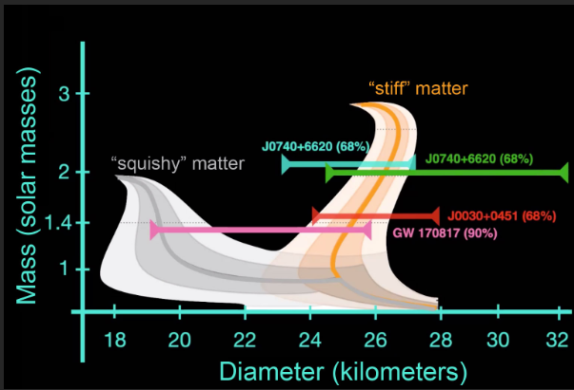| GO BACK (DESKTOP VIEW) | GO BACK (MOBILE VIEW) |
Finding the most compact configuration of neutron stars
Student:Ryan Krismer Mentor:Yuki Fujimoto (Inspire-HEP, email: yfuji@uw.edu) Prerequisites:The basic knowledge of thermodynamics and differential equation is preferred. What Students Will Do:Students will perform an analytic study with paper and pencil. They will learn about the TOV equation. They will formulate this problem by using variational calculus mimicking the procedure of finding the maximum radius configuration. What Students Will Learn:Basics of nuclear physics and general relativity. Minimal coding using scipy library of Python for the scientific calculation. Expected Project Length:6 - 12 months |
Image Credit: Sanjay Reddy / APS meeting |
Project Description:
Neutron stars are the densest object in the universe. Structure of a stable neutron star is described by the general relativistic equation called Tolman-Oppenheimer-Volkoff (TOV) equation. When an equation of state, which is the thermodynamic relation between pressure and energy density, is specified, we can solve the TOV equations. A solution to the TOV equations gives the relationship between mass and radius of a neutron star. Currently, masses of neutron stars are well measured, but the radii are not well constrained although there has been the remarkable progress in the past decades.
The purpose of this project is to find the most compact configuration of neutron stars, i.e. the smallest radius for a given mass, and the equation of state corresponding to the most compact configuration. Precisely speaking, a specific form of the equation of state was conjectured to give the minimum radius configuration, so the task is to prove/disprove this conjecture.
The configuration of neutron stars that gives the maximum radius is already known. Therefore, the minimum radius configuration, together with the maximum radius configuration, can limit the range of neutron radius. The significance of this research is that by combining our current understanding of nuclear theory and observed neutron star properties, we can gain insights about the internal structure of neutron stars [1].
References:
[1] C. Drischler, S. Han, J. M. Lattimer, M. Prakash, S. Reddy and T. Zhao, Phys. Rev. C 103, no.4, 045808 (2021) [arXiv:2009.06441 [nucl-th]].

